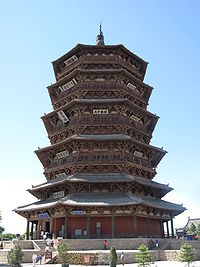
Emperor Daozong of Liao
Encyclopedia
Emperor Daozong of Liao (September 14, 1032–February 12, 1101), born Yelü Hongji or Yehlu Hongji , was an emperor
of the Liao dynasty
, a kingdom of the Khitan
people in what is now northeastern China
. Succeeding his father, Xingzong
, in 1055, Daozong ruled until he was murdered in 1101. He was succeeded by his grandson, Tianzuodi. He reigned from 28 August 1055 to 12 February 1101 .
Daozong was notable for reviving the name "Great Liao" in 1066, a designation first given the kingdom by Emperor Taizong
in 947. Other noteworthy achievements made during his reign include the completion of a Liao edition of the Buddhist Tripitaka
and the construction of the Sakyamuni Pagoda in 1056.
 He survived at least one attempt on his life in 1063, when a group of Khitans, angry that their system of tribal justice had been put under local Chinese administration, ambushed his hunting party. Daozong survived the attack and the rebels were executed, but to reassert his legitimacy as ruler he was forced to perform a traditional "rebirth" ceremony. In 1070, he restructured the legal system to reflect the differences in Chinese and Liao customs.
He survived at least one attempt on his life in 1063, when a group of Khitans, angry that their system of tribal justice had been put under local Chinese administration, ambushed his hunting party. Daozong survived the attack and the rebels were executed, but to reassert his legitimacy as ruler he was forced to perform a traditional "rebirth" ceremony. In 1070, he restructured the legal system to reflect the differences in Chinese and Liao customs.
However, Daozong's reign was fraught with corruption. Daozong spent lavishly on his palaces and his Buddhist worship. Many people under his rule were angered by the high taxes and began to rise against Liao, most notably the Jurchen tribes.
Emperor
An emperor is a monarch, usually the sovereign ruler of an empire or another type of imperial realm. Empress, the female equivalent, may indicate an emperor's wife or a woman who rules in her own right...
of the Liao dynasty
Liao Dynasty
The Liao Dynasty , also known as the Khitan Empire was an empire in East Asia that ruled over the regions of Manchuria, Mongolia, and parts of northern China proper between 9071125...
, a kingdom of the Khitan
Khitan people
thumb|250px|Khitans [[Eagle hunting|using eagles to hunt]], painted during the Chinese [[Song Dynasty]].The Khitan people , or Khitai, Kitan, or Kidan, were a nomadic Mongolic people, originally located at Mongolia and Manchuria from the 4th century...
people in what is now northeastern China
China
Chinese civilization may refer to:* China for more general discussion of the country.* Chinese culture* Greater China, the transnational community of ethnic Chinese.* History of China* Sinosphere, the area historically affected by Chinese culture...
. Succeeding his father, Xingzong
Emperor Xingzong of Liao
Emperor Xingzong of Liao , born Yelü Zongzhen , was an emperor of the Liao Dynasty. He reigned from 25 June 1031 to 28 August 1055....
, in 1055, Daozong ruled until he was murdered in 1101. He was succeeded by his grandson, Tianzuodi. He reigned from 28 August 1055 to 12 February 1101 .
Daozong was notable for reviving the name "Great Liao" in 1066, a designation first given the kingdom by Emperor Taizong
Emperor Taizong of Liao
The Emperor Taizong of Liao , born as Yelü Deguang , was the second emperor of the Khitan Empire .-Succession to the Throne:...
in 947. Other noteworthy achievements made during his reign include the completion of a Liao edition of the Buddhist Tripitaka
Tripiṭaka
' is a traditional term used by various Buddhist sects to describe their various canons of scriptures. As the name suggests, a traditionally contains three "baskets" of teachings: a , a and an .-The three categories:Tripitaka is the three main categories of texts that make up the...
and the construction of the Sakyamuni Pagoda in 1056.

However, Daozong's reign was fraught with corruption. Daozong spent lavishly on his palaces and his Buddhist worship. Many people under his rule were angered by the high taxes and began to rise against Liao, most notably the Jurchen tribes.

